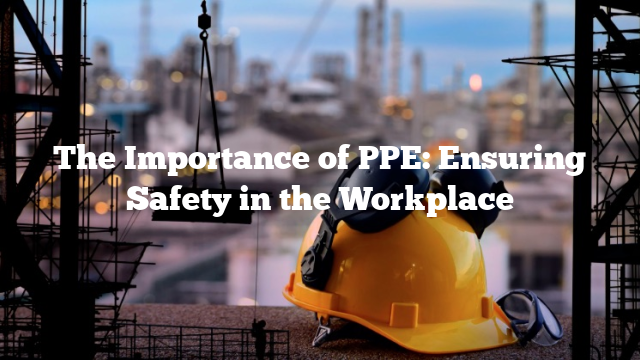PPE Safety Meeting Topics: Ensuring Workplace Safety
👋 Welcome to our comprehensive guide on PPE safety meeting topics. Whether you are an employer, manager, or employee, understanding the importance of personal protective equipment (PPE) is crucial for maintaining a safe work environment.
Why PPE Safety Meetings Are Essential
PPE safety meetings play a vital role in promoting workplace safety. These meetings allow employers and employees to discuss and address potential hazards, reinforce best practices, and ensure the proper use of personal protective equipment. By conducting regular safety meetings, organizations can prevent accidents, injuries, and even fatalities.
Main Points of This Article
In this article, we will explore various PPE safety meeting topics that cover a wide range of industries and occupations. We will discuss the importance of PPE, provide facts about its usage, share a listicle of essential PPE items, offer a tutorial on conducting effective safety meetings, and provide valuable tips for ensuring compliance and engagement.
What Is PPE and Why Is It Important?
Personal Protective Equipment, commonly known as PPE, refers to gear, clothing, or equipment designed to protect workers from potential hazards in the workplace. This can include items such as helmets, gloves, safety glasses, respirators, and protective clothing.
PPE is important because it acts as a barrier between the worker and potential hazards, reducing the risk of injuries or illnesses. By wearing appropriate PPE, employees can safeguard themselves against various workplace hazards, such as falling objects, chemical exposures, noise, and more.
Facts about PPE Usage
Before delving into specific PPE safety meeting topics, let’s highlight some key facts about PPE usage:
| Fact |
Details |
| 1 |
PPE should be provided by employers at no cost to employees. |
| 2 |
PPE must be suitable for the specific hazards present in the workplace. |
| 3 |
Training on proper PPE usage and maintenance is essential. |
| 4 |
PPE should be inspected regularly for damage or wear and tear. |
A Listicle of Essential PPE Items
When it comes to PPE, different industries and occupations require specific protective equipment. Here is a listicle of essential PPE items based on common workplace hazards:
- Hard Hats: Protects against head injuries from falling objects or overhead hazards.
- Safety Glasses: Shields the eyes from flying debris, chemicals, or intense light sources.
- Gloves: Prevents hand injuries caused by cuts, burns, chemical exposure, or extreme temperatures.
- Respirators: Filters out harmful airborne particles, gases, or vapors.
- Earplugs or Earmuffs: Reduces noise exposure and protects hearing.
- High-Visibility Clothing: Enhances visibility in low-light or high-traffic areas.
- Safety Shoes: Provides foot protection against heavy objects, punctures, or electrical hazards.
Tutorial of PPE Safety Meeting Topics
To conduct effective PPE safety meetings, follow these steps:
- Identify the specific PPE requirements for your workplace.
- Prepare an agenda that covers relevant topics, including PPE selection, usage, maintenance, and emergency procedures.
- Engage participants by encouraging open discussions and addressing their concerns or questions.
- Use visual aids, such as posters or videos, to reinforce key points and demonstrate proper PPE usage.
- Ensure everyone understands the importance of PPE compliance and the consequences of non-compliance.
- Conduct regular follow-ups to assess the effectiveness of the safety meetings and make necessary improvements.
Tips for Ensuring PPE Compliance and Engagement
To maximize PPE compliance and engagement in the workplace, consider the following tips:
- Lead by example: Managers and supervisors should always wear appropriate PPE, setting a positive example for employees.
- Provide comprehensive training: Ensure all employees receive proper training on PPE usage, maintenance, and limitations.
- Regularly inspect and replace PPE: Conduct routine inspections and promptly replace damaged or expired equipment.
- Solicit employee feedback: Encourage workers to provide input on PPE selection and comfort to increase compliance and satisfaction.
- Recognize and reward compliance: Acknowledge and reward employees who consistently follow PPE guidelines, fostering a culture of safety.
Question and Answer of PPE Safety Meeting Topics
Q1: How often should PPE safety meetings be conducted?
A1: PPE safety meetings should be conducted regularly, ideally on a monthly or quarterly basis. However, the frequency may vary depending on the nature of the workplace and the specific hazards involved.
Q2: Can PPE completely eliminate workplace hazards?
A2: While PPE plays a crucial role in reducing workplace hazards, it does not eliminate them entirely. Employers must also focus on implementing engineering controls, administrative measures, and proper training to minimize risks.
Q3: What should I do if an employee refuses to wear PPE?
A3: If an employee refuses to wear proper PPE despite training and awareness, address the issue promptly. Reiterate the importance of PPE usage, educate the employee on the potential consequences, and consider appropriate disciplinary actions as outlined in your workplace policies.
Q4: How can I ensure PPE fits properly?
A4: Proper fit is crucial for the effectiveness of PPE. Provide employees with different sizes or options to choose from, conduct fit tests if required (e.g., respirators), and regularly remind workers to report any discomfort or issues with their PPE.
Conclusion of PPE Safety Meeting Topics
🎉 In conclusion, conducting regular PPE safety meetings is vital for ensuring workplace safety and reducing the risk of accidents. By addressing specific PPE topics, providing valuable information, and engaging employees, organizations can foster a culture of safety and protect their most valuable asset – their workforce. Remember, PPE is not just a requirement; it is a commitment to each other’s well-being.
Recommendations:
- Safety Slogansquotes Safety sayings and quotes. Below you will find our collection of inspirational wise and humorous old safety quotes safety sayings and safety proverbs collected over the years from a variety…
- Safety Training Topics Training topics can vary depending on the operations and activities at a particular location. Toolbox topics are used to cover a variety of short safety training subjects and to remind…
- Office Safety Meeting Topics Tool box talks safety moments and pre start meetings have become a very effective way of maintaining safety awareness and bringing attention to any current or emerging hazards and risks.…
- Catchy Safety Slogans For The Workplace In this post we are going to share with you a list of 57 funny safety slogans. Here are best safety slogans for workplace. 201 Catchy Safety Slogans For The…
- Safety Topics For The Workplace The centers for disease control and prevention cdc cannot attest to the accuracy of a non federal website. Violence in the workplace. Safety Topics For The Workplace Anthony Public Safety…
- 1 Minute Safety Topics Each slide delivers focused talking points that can be presented in any meeting as a one minute opener or to launch a more extensive discussion. 5 minute safety topics. 5…
- Health And Safety Slogans For The Workplace As described in our earlier post on safety slogans safety posters can be installed throughout the organization to educate employees to work safely. At work at home let safety be…
- General Safety Topics Federal osha and state regulatory compliance information in plain english. Motor carrier safety. General Workplace Safety Process safety management construction recordkeeping general. General safety topics. Free safety topics toolbox talks…
- Safety Poster While we are talking about safety poster, most of us need to be a lot more familiar with the safety element of our lives.
- Workplace Safety Topics For Meetings Fresh ideas for tailgate meetings or safety moments at work. Health safety committee member health care provider. Coping With Stress At Home Bheema Office Safety Safety Posters If not choose…
- Site Safety Inspection Checklist They will give you some indication of where you should begin action. Weekly site safety inspection checklist. Jobsite Safety Inspection Checklist Mcaa Place next to each item that is satisfactoryplace…
- Health And Safety Topics For Meetings Choosing the right eye protection. Staying within the limits of an extended. Coping With Stress At Home Bheema Office Safety Safety Posters The following article lists some relevant safety topics…
- Workplace Safety Slogans Safety First Quotes See more ideas about safety slogans workplace safety and safety. 167 catchy and funny safety slogans for workplaces 2020 find the best catchy safety slogans for your workplace stop press.…
- Funny Safety Quotes For Work Im sure youll remember at least a few of these safety quotes. Im not going to lie. Funny Safety Quotes Safety Toolbox Talks Meeting Topics If you get killed at…
- Huge Safety Slogans Complete List Made Your Safety… Browse through the safety slogans in 2022 suggestions below. The safety slogans is one of Safety Communication method which successful of safety campaign was measured. So Safety Slogans is so…
- Health And Safety Site Inspection Template Where a health and safety representative has drawn your attention to the findings of an inspection they have. Health and safety annual audit action plan. Form 007 Hse Weekly Inspection…
- Health And Safety Inspection Report Template Use for office health and safety audits. Add a badge to your website or intranet so your workers can quickly find answers to their health and safety questions. Safety Report…
- Safety Quotes Images A safety leader will go above and beyond to make safety a priorityfor themselves and for those around them. Safety images photos unsafe pictures and funny fails. Safety Doesn T…
- Safety Topics For Workplace Process safety management construction recordkeeping general. These tips from safetyhealth magazine make a good starting point for safety committee talks or safety moments. Workplace Safety Topics Lovetoknow If youre like…
- Safety Topics For Work Sign up to receive a monthly email digest of the latest office safety tips. Here are 11 tips for effective workplace housekeeping. Workplace Safety Topics Lovetoknow Fresh ideas for tailgate…
- Inspirational Safety Quotes For Workplace Relevant quotes are a great way to communicate key safety concepts. The use of silly and meaningless safety language matters it creates a distraction and delusion that safety and risk…
- Office Safety Topics Oshas safety and health topics pages provide regulatory and enforcement information hazard identification and controls as well as best practices and other resources to assist employers workers and safety and.…
- Construction Safety Inspection Checklist Template It can be completed in a single inspection or over a series of shorter inspections. Includes checks for first aid facilities fire prevention emergencies site security ppe and more. Construction…
- Safety Quotes For The Workplace Funny In this post we are going to share with you a list of 57 funny safety slogans. Researchers reveal the top 10 most effective safety slogans ever click here. Funny…
- Safety Quotes Workplace Display them around your workplace or add them to internal newsletters. The use of silly and meaningless safety slogans matters it creates a distraction and delusion that safety and risk…
- Safety Quotes Pictures A group of wonderfully cared for confident individuals will generate great ideas. You are looking for the safety quotes which helps us to free from harm or danger. Safety Doesn…
- Safety Topics Construction Out of all the sub categories of safety talks published here on safety talk ideas the construction industry has the largest amount of topics available. Toolbox talks are an easy…
- Workplace Safety Inspection Checklist Includes checks for fire prevention general safety vehicles. Date item condition follow up needed. Pshsa Sample Workplace Inspection Checklist The best checklist for your workplace is one that has been…
- Safety Inspection Report Template In line with this we have here safety report templates that you can download and use. Neglecting such reports could bring out legal and administrative consequences. Safety Report Templates 16…
- Good Safety Topics Find and save ideas about workplace safety topics on pinterest. These safety talks and safety training topics help you keep interest high during safety training session and are also great…
Advertisement
Scroll to Continue With Content




